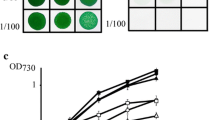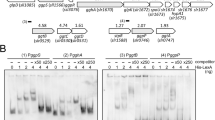Abstract
Following a N-methyl-N′-nitro-N-nitrosoguanidine-based mutagenesis of Synechococcus elongatus PCC 7942 wild type, we were able to select several mutants with an enhanced tolerance toward the herbicide bentazone (3-isopropyl-1H-2,1,3-benzothiadiazine-4(3H)-one 2,2-dioxide). Mutant Mu1 has in part been previously characterized. In the present paper we report on another mutant, called Mu2, which also has a higher tolerance toward bentazone. Since Mu2 showed a better growth than WT when cultivated with elevated NaCl concentrations in the growth medium and since S. elongatus WT has previously been classified to be low salt tolerant, we were especially interested in the identification of the modifications conferring this higher salt tolerance to mutant Mu2. Immunoblot analyses provided evidence that Mu2 had a constitutively higher expression of PsbO and of IsiA. In addition, in Mu2 a significantly higher concentration of IdiA was detected under salt stress as compared to WT. These three proteins most likely contribute to a better protection and/or stabilization of photosystem II. Moreover, Mu2 had a higher amount of the photosystem I reaction center proteins PsaAB under salt stress than WT. In addition, the amount of the ferredoxin:NADP+ oxidoreductase and also of the ATP synthase was constitutively higher in Mu2 than in WT. In contrast to WT the latter two proteins did not decrease under salt stress in Mu2. Therefore, it can be assumed that Mu2 could maintain a high cyclic electron transport activity around photosystem I under salt stress. It can be assumed that the combination of these modifications of the electron transport chain cause a better protection of photosystem II against oxidative damage and cause an increase of cyclic electron transport activity around photosystem I with ATP synthesis. Thus, the overall cellular energization in Mu2 relative to WT is improved. Together with putative other not yet identified modifications this seems to enable Mu2 to energize its cytoplasmic membrane-localized ion pumps more effectively than WT and, as a consequence, to keep the intracellular NaCl concentration low.












Similar content being viewed by others
Abbreviations
- Asc.:
-
Ascorbate
- DCPIP:
-
2,6-Dichlorophenolindophenol
- Chl a :
-
Chlorophyll a
- CS:
-
Cell suspension
- FNR:
-
Ferredoxin:NADP+ oxidoreductase
- Mu2:
-
Bentazone-resistant Synechococcus elongatus PCC 7942 mutant
- MV:
-
Methylviologen
- NSG:
-
N-methyl-N′-nitro-N-nitrosoguanidine
- PCV:
-
Packed cell volume
- PS:
-
Photosystem
- WT:
-
Wild type
References
Allakhverdiev SI, Klimov VV, Hagemann M (2005) Cellular energization protects the photosynthetic machinery against salt-induced inactivation in Synechococcus. Biochim Biophys Acta 1708:201–208
Allakhverdiev SI, Nishiyama Y, Suzuki I, Tasaka Y, Murata N (1999) Genetic engineering of the unsaturation of fatty acids in membrane lipids alters the tolerance of Synechocystis to salt stress. Proc Natl Acad Sci USA 96:5862–5867
Aro EM, Virgin I, Andersson B (1993) Photoinhibition of photosystem II. Inactivation, protein damage and turnover. Biochem Biophys Acta 1143:113–134
Bagchi SN, Pistorius EK, Michel KP (2003) A Synechococcus sp. PCC 7942 mutant with a higher tolerance towards bentazone. Photosynth Res 75:171–182
Barber J, Nield J, Duncan J, Bibby TS (2006) Accessory chlorophyll proteins in cyanobacterial photosystem I. In: Goldbeck JH (ed) Photosystem I: the light-driven plastocyanin:ferredoxin oxidoreductase. Springer, Dordrecht, The Netherlands, pp 99–117
Bibby TS, Nield J, Barber J (2001) Iron deficiency induces the formation of an antenna ring around trimeric photosystem I in cyanobacteria. Nature 412:743–745
Boekema EJ, Hifney A, Yakushevska AE, Piotrowski M, Keegstra W, Berry S, Michel KP, Pistorius EK, Kruip J (2001) A giant chlorophyll–protein complex induced by iron deficiency in cyanobacteria. Nature 412:745–748
Burnap RL, Troyan T, Sherman LA (1993) The highly abundant chlorophyll–protein complex of iron-deficient Synechococcus sp. PCC 7942 (CP43′) is encoded by the isiA gene. Plant Physiol 103:893–902
De Las Rivas J, Balsera M, Barber J (2004) Evolution of oxygenic photosynthesis: genome-wide analysis of the OEC extrinsic proteins. Trends Plant Sci 9:18–25
Deshnium P, Los DA, Hayashi H, Mustardy L, Murata N (1995) Transformation of Synechococcus with a gene for choline oxidase enhances tolerance to salt stress. Plant Mol Biol 29:897–907
Duhring U, Axmann IM, Hess WR, Wilde A (2006) An internal antisense RNA regulates expression of the photosynthesis gene isiA. Proc Natl Acad Sci USA 103:7054–7058
Durham KA, Bullerjahn GS (2002) Immunocytochemical localization of the stress-induced DpsA protein in the cyanobacterium Synechococcus sp. strain PCC 7942. J Basic Microbiol 42:367–372
Dwivedi K, Sen A, Bullerjahn GS (1997) Expression and mutagenesis of the dpsA gene of Synechococcus sp. PCC 7942, encoding a DNA-binding protein involved in oxidative stress protection. FEMS Microbiol Lett 155:85–91
Exss-Sonne P, Tölle J, Bader KP, Pistorius EK, Michel KP (2000) The IdiA protein of Synechococcus sp. PCC 7942 functions in protecting photosystem II under oxidative stress. Photosynth Res 63:145–157
Ghassemian M, Straus NA (1996) Fur regulates the expression of iron-stress genes in the cyanobacterium Synechococcus sp. strain PCC 7942. Microbiology 142:1469–1476
Golden SS, Sherman LA (1984) Biochemical and biophysical characterization of herbicide-resistant mutants of the unicellular cyanobacterium, Anacystis nidulans R2. Biochim Biophys Acta 764:239–246
Herdman M, Castenholz RW, Iteman I, Waterbury JB, Rippka R (2000) The archae, cyanobacteria and deeply branching bacteria. In: Boone DR, Castenholz RW, Garrity GM (eds) Bergey’s manual of systematic bacteriology. Springer-Verlag, New York
Jeanjean R, Matthijs HC, Onana B, Havaux M, Joset F (1993) Exposure of the cyanobacterium Synechocystis sp. PCC 6803 to salt stress induces concerted changes in respiration and photosynthesis. Plant Cell Physiol 34:1073–1079
Joset F, Jeanjean R, Hagemann M (1996) Dynamics of the response of cyanobacteria to salt stress: deciphering the molecular events. Physiol Plant 96:738–744
Kaku N, Hibino T, Tanaka Y, Ishikawa H, Araki E, Takabe T (2000) Effects of overexpression of Escherichia coli katE and bet genes on the tolerance for salt stress in a freshwater cyanobacterium Synechococcus sp. PCC 7942. Plant Sci 159:281–288
Ke B (2001) Photosynthesis: photobiochemistry and photobiophysics. Kluwer Academic Publishers, Dordrecht
Kunert A, Vinnemeier J, Erdmann N, Hagemann M (2003) Repression by Fur is not the main mechanism controlling the iron-inducible isiAB operon in the cyanobacterium Synechocystis sp. PCC 6803. FEMS Microbiol Lett 227:255–262
Laberge D, Rouillon R, Carpentier R (2000) Comparative study of thylakoid membranes sensitivity for herbicide detection after physical or chemical immobilization. Enzyme Microb Technol 26:332–336
Laemmli UK (1970) Cleavage of structural proteins during the assembly of the head of bacteriophage T4. Nature 227:680–685
Lax JA, Arteni AA, Boekema EJ, Pistorius EK, Michel KP, Rogner M (2007) Structural response of photosystem 2 to iron deficiency: characterization of a new photosystem 2-IdiA complex from the cyanobacterium Thermosynechococcus elongatus BP-1. Biochim Biophys Acta (in press)
Mallipudi LR, Gleason FK (1989) Characterization of a mutant of Anacystis nidulans R2 resistant to the natural herbicide cyanobacterin. Plant Sci 60:149–154
Marin K, Zuther E, Kerstan T, Kunert A, Hagemann M (1998) The ggpS gene from Synechocystis sp. strain PCC 6803 encoding glucosyl-glycerol-phosphate synthase is involved in osmolyte synthesis. J Bacteriol 180:4843–4849
Matthijs HC, Jeanjean R, Yeremenko N, Huiwman J, Joset F, Hellingwerf KJ (2002) Hypothesis: versatile function of ferredoxin-NADP+ reductase in cyanobacteria provides regulation for transient photosystem I-driven cyclic electron transport. Funct Plant Biol 29:201–210
Meunier PC, Colon-Lopez MS, Sherman LA (1997) Temporal changes in state transitions and photosystem organization in the unicellular, diazotrophic cyanobacterium Cyanothece sp. ATCC 51142. Plant Physiol 115:991–1000
Michel KP, Berry S, Hifney A, Pistorius EK (2003) Adaptation to iron deficiency: a comparison between the cyanobacterium Synechococcus elongatus PCC 7942 wild-type and a DpsA-free mutant. Photosynth Res 75:71–84
Michel KP, Krüger F, Pühler A, Pistorius EK (1999) Molecular characterization of idiA and adjacent genes in the cyanobacteria Synechococcus sp. strains PCC 6301 and PCC 7942. Microbiology 145:1473–1484
Michel KP, Pistorius EK (2004) Adaptation of the photosynthetic electron transport chain in cyanobacteria to iron deficiency: the function of IdiA and IsiA. Physiol Plant 119:1–15
Michel KP, Pistorius EK, Golden SS (2001) Unusual regulatory elements for iron deficiency induction of the idiA gene of Synechococcus elongatus PCC 7942. J Bacteriol 183:5015–5024
Michel KP, Thole HH, Pistorius EK (1996) IdiA, a 34 kDa protein in the cyanobacteria Synechococcus sp. strains PCC 6301 and PCC 7942, is required for growth under iron and manganese limitations. Microbiology 142:2635–2645
Mullineaux CW, Allen F (1990) State 1–State 2 transitions in the cyanobacterium Synechococcus 6301 are controlled by the redox state of electron carriers between photosystem I and II. Photosynth Res 23:297–311
Nield J, Morris EP, Bibby TS, Barber J (2003) Structural analysis of the photosystem I supercomplex of cyanobacteria induced by iron deficiency. Biochemistry 42:3180–3188
Nomura M, Ishitani M, Takabe T, Rai AK (1995) Synechococcus sp. PCC7942 transformed with Escherichia coli bet genes produces glycine betaine from choline and acquires resistance to salt stress. Plant Physiol 107:703–708
Oren A (2000) Salts and brines. In: Whitton BA, Potts M (eds) The ecology of cyanobacteria: their diversity in time and space. Kluwer Academic Publishers, Dordrecht, pp 281–306
Reed RH, Stewart WDP (1988) The responses of cyanobacteria to salt stress. In: Rogers LJ, Gallon JR (eds) Biochemistry of algae and cyanobacteria. Europe TPSo Oxford Science Publisher, Oxford, pp 217–231
Sambrook J, Fritsch EF, Maniatis T (1989) Molecular cloning: a laboratory manual 2 edn. Cold Spring Harbor Laboratory, New York
Schaegger H, von Jagow G (1987) Tricine-sodium dodecylsulphate-polyacrylamide gel electrophoresis for the separation of proteins in the range from 1 to 100 kDa. Anal Biochem 166:368–379
Stephan DP, Ruppel HG, Pistorius EK (2000) Interrelation between cyanophycin synthesis, l-arginine catabolism and photosynthesis in the cyanobacterium Synechocystis sp. strain PCC 6803. Z Naturforsch [C] 55:927–942
Tölle J, Michel KP, Kruip J, Kahmann U, Preisfeld A, Pistorius EK (2002) Localization and function of the IdiA homologue Slr1295 in the cyanobacterium Synechocystis sp. strain PCC 6803. Microbiology 148:3293–3305
van Thor JJ, Jeanjean R, Havaux M, Sjollema KA, Joset F, Hellingwerf KJ, Matthijs HC (2000) Salt shock-inducible photosystem I cyclic electron transfer in Synechocystis PCC6803 relies on binding of ferredoxin:NADP(+) reductase to the thylakoid membranes via its CpcD phycobilisome-linker homologous N-terminal domain. Biochim Biophys Acta 1457:129–144
Vinnemeier J, Hagemann M (1999) Identification of salt-regulated genes in the genome of the cyanobacterium Synechocystis sp. strain PCC 6803 by subtractive RNA hybridization. Arch Microbiol 172:377–386
Vinnemeier J, Kunert A, Hagemann M (1998) Transcriptional analysis of the isiAB operon in salt-stressed cells of the cyanobacterium Synechocystis sp. PCC 6803. FEMS Microbiol Lett 169:323–330
Waditee R, Hibino T, Nakamura T, Incharoensakdi A, Takabe T (2002) Overexpression of a Na+/H+ antiporter confers salt tolerance on a freshwater cyanobacterium, making it capable of growth in sea water. PNAS 99:4109–4114
Yeremenko N, Jeanjean R, Prommeenate P, Krasikov V, Nixon PJ, Vermaas WF, Havaux M, Matthijs HC (2005) Open reading frame ssr2016 is required for antimycin A-sensitive photosystem I-driven cyclic electron flow in the cyanobacterium Synechocystis sp. PCC 6803. Plant Cell Physiol 46:1433–1436
Yousef N, Pistorius EK, Michel KP (2003) Comparative analysis of idiA and isiA transcription under iron starvation and oxidative stress in Synechococcus elongatus PCC 7942 wild type and selected mutants. Arch Microbiol 180:471–483
Acknowledgments
The fellowship of the Humboldt Foundation to Prof. Dr. S. N. Bagchi and the financial support of the DFG are gratefully acknowledged. Moreover, we thank Prof. Dr. W. Hess, Prof. Dr. G. S. Bullerjahn, and Dr. J. Kruip for the kind gift of the anti-IsiA, the anti-DpsA, and the anti-PsaAB antisera. Bentazone was a kind gift of Dr. Kirstgen of the BASF.
Author information
Authors and Affiliations
Corresponding author
Rights and permissions
About this article
Cite this article
Bagchi, S.N., Bitz, T., Pistorius, E.K. et al. A Synechococcus elongatus PCC 7942 mutant with a higher tolerance toward the herbicide bentazone also confers resistance to sodium chloride stress. Photosynth Res 92, 87–101 (2007). https://doi.org/10.1007/s11120-007-9176-y
Received:
Accepted:
Published:
Issue Date:
DOI: https://doi.org/10.1007/s11120-007-9176-y




